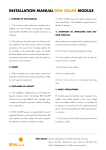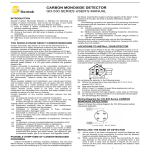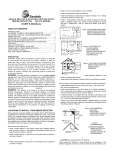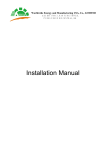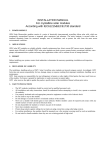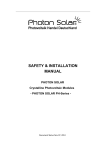Download Installation Manual of Solar Module
Transcript
宁波尤利卡太阳能科技发展有限公司 NINGBO ULICA SOLAR SCIENCE & TECHNOLOGY CO., LTD. Installation Manual of Solar Module 1. Purpose of this Manual 1.1 This manual contains information regarding the installation and safe handling of photovoltaic modules made by Ninbo Ulica Solar Science & Technology Co., Ltd, which hereafter referred to as "modules" . 1.2 All instructions should be read and understood before installation. The installer should conform to all safety precautions in the manual when installing modules. Before installing a solar photovoltaic system, the installer should be familiar with the mechanical and electrical requirements for photovoltaic systems. Keep this guide in a safe place for future reference. 2. Permit 2.1 Before installation your system, please contact local authorities to determine the necessary permitting, installation and inspection requirement. 3. Disclaimer of liability 3.1 The installation, handling and use of modules are beyond company control .Accordingly, Ulica solar does not assume responsibility for loss, damage, injury or expense resulting from improper installation handling, use or maintenance. 3.2 Ulica solar assumes no responsibility for any infringement of patents or other rights of the third parties that may result from use of the modules. No license is granted by implication or under any patents or its rights. 3.3 Ulica solar reserves the right to update the products, specification or this installation manual without notification in advance. 4. Attention to unpacking and storing modules Utmost attentions are required while unpacking & transporting & storing the modules as following. 4.1 Don’t strike or physically damage the module. 4.2 Carry modules with both hands. Don’t use the connection socket as a handle. 4.3 Don’t stand on the module. 4.4 Don’t twist the module. 4.5 Don’t mark on the rear of the module with sharp tools. 5. Safety Precautions PV modules generate electricity when exposed to the sunlight .One module produce a safe ,lower voltage level, but multiple modules in series or in parallel will be danger .To avoid the risk of fire ,sparking and fatal electric shock during handling , the following precautions is necessary: 5.1 Don’t insert any electrically conducting material into the plugs or sockets. 5.2 Don’t fit solar modules and wiring with wet plugs and sockets. 5.3 Make sure to use safety equipments (such as :insulated tools, insulated gloves, etc) during wiring. 中国·浙江省宁波市鄞州区望春工业园区杉杉路 1 号 邮编 PC:315177 No.1,Shanshan Road,Wangchun Industrial District, Ningbo, China,PC:315177 Tel: 86-574-28828976 Fax: 86-574-28828973 宁波尤利卡太阳能科技发展有限公司 NINGBO ULICA SOLAR SCIENCE & TECHNOLOGY CO., LTD. 5.4 Make sure that the connection is made when the circuitry is cut off. Don’t disconnect under load. 5.5 To prevent the electric arc, please ensure that the connectors is available (without any contamination and worn out). 6. Climate Condition Install the PV modules as following conditions: 6.1 Ambient temperature : -40 ℃ to 40℃. 6.2 Operating temperature : -40 ℃ to 85℃. 6.3 Storage temperature: -30 ℃ to 50℃. 6.4 Humidity: below 85RH% 6.5 Snowfall pressure: below 5400Pa. 6.6 Wind pressure: below 3000Pa. 6.7 Water resistance: don’t install the PV module in a place where it would be immersed in water or continually exposed to water from a sprinkler or fountain etc. 6.8 Corrosion resistance: far from corrosive salt area and sulfurous area. 7. Orientation: 7.1 Install the PV module facing South (in Northern Hemisphere), or North (in Southern Hemisphere). Module facing West or East can generate a smaller amount of electricity than facing South (in Northern Hemisphere), or North (in Southern Hemisphere). Incorrect orientation will result in loss of power output. 7.2 PV modules connected in series should be installed in same orientation and angle. Different orientation or angle may cause loss of output power due to difference of amount of sunlight exposed to the module. 7.3 Install the PV as free as possible from shading. Shading causes loss of output, even though the factory fitted bypass diode of the PV module will minimize any such loss. 7.4The PV modules connected in series should be installed at same orientation and angle. Different orientation or angle may cause loss of output power due to difference of amount of sunlight exposed to the module. 7.5The PV modules produce the most power when they are pointed directly at the sun. For installations where the PV modules are attached to a permanent structure, the PV modules should be tilted for optimum winter performance. As a rule, if the system power production is adequate in winter, it will be satisfactory during the rest of the year. The module tilt angle is measured between the solar modules and the ground (Figure 1). Optimal tilting of PV module is almost the same as the latitude of installation location. 中国·浙江省宁波市鄞州区望春工业园区杉杉路 1 号 邮编 PC:315177 No.1,Shanshan Road,Wangchun Industrial District, Ningbo, China,PC:315177 Tel: 86-574-28828976 Fax: 86-574-28828973 宁波尤利卡太阳能科技发展有限公司 NINGBO ULICA SOLAR SCIENCE & TECHNOLOGY CO., LTD. Figure 1 PV Module Tilt Angle 8. Mount and Notes: 8.1 Use appropriate methods to mount PV modules. Fall of modules from high place will cause death, injury or damage. 8.2 Don’t disassemble, bend, impact by sharp objects, walk on, and throw or drop etc. 8.3 Don’t connect by demolishing or breaking the junction box, connector and guide wire. You’d better follow up the installation instruction to assemble module. When installing, the slope of module should be less than 5 in/ft. 8.4 You can choose this fix-up method to support the module as the least requirement. 8.5 Each module should be fixed by at least 4 points along the length of the frame. 8.6 Use the existing fixing holes instead of drilling additional holes for installation. The installation and attachment material (nuts, washer, bolt) must be corrosion-resistant. Moments of force is 5N*m for module mounting. 8.7 The most common mounting is achieved by mounting the module using the four symmetry points close to the inner side on module frame. If excessive wind or snow loads are expected, all eight mounting holes must be used. Figure 2 PV module Mechanical drawing 中国·浙江省宁波市鄞州区望春工业园区杉杉路 1 号 邮编 PC:315177 No.1,Shanshan Road,Wangchun Industrial District, Ningbo, China,PC:315177 Tel: 86-574-28828976 Fax: 86-574-28828973 宁波尤利卡太阳能科技发展有限公司 NINGBO ULICA SOLAR SCIENCE & TECHNOLOGY CO., LTD. 8.8 Ulica PV modules can be mounted using the following methods: (Note: All installation methods herein are only for reference, and Ulica solar will not provide related BOS components, the system installer or trained professional personnel must be esponsible for the PV system’s design, installation, and mechanical load calculation and security of the system.) − Using corrosion-proof screws (M8) in the existing installing holes in the module frame. − Using suitable module clamps on the long side of the module frame to mount the modules (“portrait orientation”) 1) Screw fitting: The frame of each module has 4 mounting holes (Length* Width: 18mm*9mm) used to secure the modules to supporting structure. The module frame must be attached to a mounting rail using M8 corrosion-proof screws together with spring washers and flat washers in four symmetrical locations on the module. The applied torque should be approximately 5 Newton-meters. Please find detailed mounting information. Figure 3 PV module installed with Screw fitting method 2) Clamp fitting (portrait orientation): Use a certain number of clamps to fix the modules on the mounting rail. The module clamps should not come into contact with the front glass and must not deform the frame. Be sure to avoid shadowing effects from the module clamps. The module frame is not to be modified under any circumstances. When choosing this type of clamp-mounting method, please be sure to use at least four clamps on each module, two clamps should be attached on the long sides of the module. Depending on the local wind and snow loads, additional clamps may be required to ensure the module can bear the load. The applied torque should be about 8 Newton-meters. 中国·浙江省宁波市鄞州区望春工业园区杉杉路 1 号 邮编 PC:315177 No.1,Shanshan Road,Wangchun Industrial District, Ningbo, China,PC:315177 Tel: 86-574-28828976 Fax: 86-574-28828973 宁波尤利卡太阳能科技发展有限公司 NINGBO ULICA SOLAR SCIENCE & TECHNOLOGY CO., LTD. The movement of the mounting rail and the clamps center line are recommended to the mounting holes Figure 4 PV module installed at portrait orientation with Clamp fitting method 8.7 To ensure the building safety, the recommended standoff height is 20 cm. For rooftop installation, a minimum slope of 5cm/12 cm is required. 9. Grounding: Grounding is always to be used in order to improve system safety. The grounded connection must be made by a qualified electrician as request following, 9.1 All module frames and its racks must be properly grounded in accordance with the appropriate respective national electrical code. 9.2 The grounding conductor or strap may be copper, copper alloy or other material acceptable for use as an electrical conductor per respective National Electrical Codes. The grounding conductor must make a connection to earth using a suitable earth ground electrode. 中国·浙江省宁波市鄞州区望春工业园区杉杉路 1 号 邮编 PC:315177 No.1,Shanshan Road,Wangchun Industrial District, Ningbo, China,PC:315177 Tel: 86-574-28828976 Fax: 86-574-28828973 宁波尤利卡太阳能科技发展有限公司 NINGBO ULICA SOLAR SCIENCE & TECHNOLOGY CO., LTD. Figure 5 Schematic drawing for PV module grounding 10. Wiring and Notes: 10.1 To minimize the risk of indirect lighting strike, avoid forming closed loops when designing the system. Check that wiring is correct before starting the generator. If the measured open circuit voltage and short-circuit current differ from the specifications, there may be a wiring fault. 10.2 The plug connector has its own polarity. Make sure that the connection is safe and tight. The plug connector should not receive external trees. Connectors should only be used to connect the circuit. But never use to turn the circuit on or off. 10.3 Ensure that all materials meet the requirements of the system maximum voltage, current, moisture and temperature when they are exposed to sunlight. Normally, PV module is likely to produce more current and/or voltage than that reported under Standard Test Conditions. Accordingly the values of Isc and Voc marked on the module should be multiplied by a factor of 1.25 when selecting electrical components voltage rating, conductor capacities, fuse type, and type of control components connected to the PV output. 11. Maintenance: 11.1 Check if mounting structure is loose. If necessary, please tighten the loose component again. 11.2 Check connections of cables, grounding cables and connectors periodically. 11.3 Often clean the face with soft cloth etc. 11.4 If changing one of module, the same kind and type is needed. 11.5 Don’t touch live parts of cable and connectors. Must use appropriate safety equipment (such as: insulated tools, insulated gloves. 11.6 Strongly recommend covering the front surface of the PV module by an opaque cloth or other material when repairing because the PV modules under the sunlight generate high voltage and are danger. 中国·浙江省宁波市鄞州区望春工业园区杉杉路 1 号 邮编 PC:315177 No.1,Shanshan Road,Wangchun Industrial District, Ningbo, China,PC:315177 Tel: 86-574-28828976 Fax: 86-574-28828973






